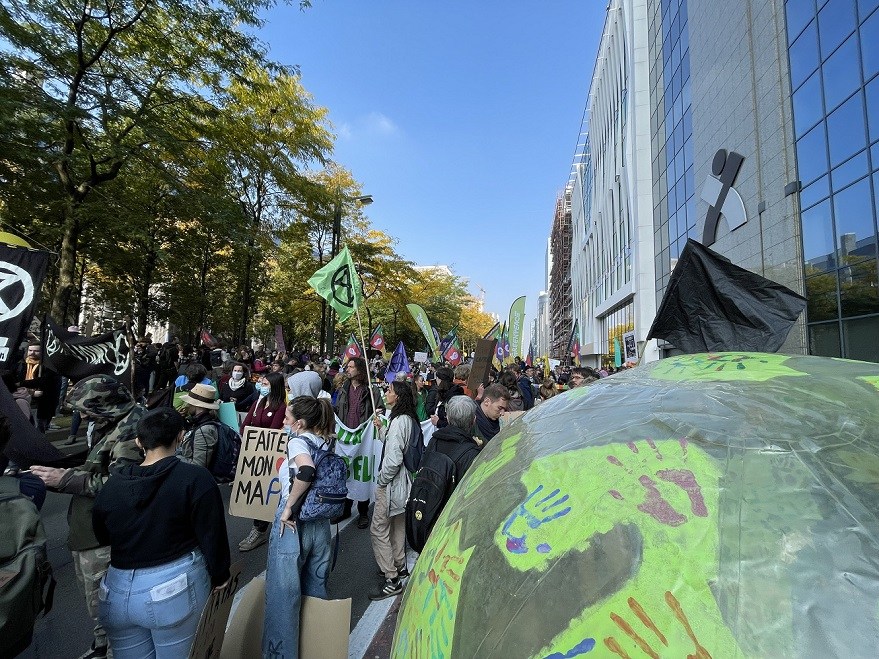Last Sunday, the weather was quite pleasant and I decided to go for a walk in Parc du Cinquantenaire in Brussels. It took me by surprise to see loads of people marching across the park. I curiously looked at the banners they were carrying and realized that it was a climate march.
The circumstances of my Sunday walk were inspiring for they made the question I had previously received from a colleague of mine re-appear in my head. What are the chances for the EU Green Deal to succeed and what will its implementation broadly mean for the European continent and beyond? I think that to answer this question, what we have to consider is the scale of the change in front of which we are standing.
From the global macro-perspective, one of the aspects we have to realize is that changing our energy sources is going to re-shape the geopolitical map of the world. In the next 30 years, it is the ambition of the European Commission to shift the EU energy mix radically away from coal, oil and natural gas and increasingly towards renewables and bioenergy (see the Bruegel/ECFR graph below).
At the same time, the European Commission intends to decrease the EU’s energy supply dependency on third countries (e.g. under the ReFuelEU Aviation proposal the Commission is aiming at 92% of all sustainable aviation fuels used in Europe be produced in the EU by 2050).
This might sound nicely but it is also easy to imagine that, if successful, such a move will have far-reaching geopolitical implications. In order to ensure the EU energy security, the following suggestions made by the Brussels based economic think-tank Bruegel invite to be viewed as fairly reasonable: The EU needs to re-think its “relationships with important neighbourhood countries such as Russia and Algeria, and with global players including the United States, China and Saudi Arabia.”

Source: Bruegel/ECFR based on European Commission (2020)
From the micro-perspective (regional), changing our energy sources is going to translate into a re-definition of the ways our economies work with unforeseeable ramifications of the political, social, and industrial consequences.
Let me give you a little example here. The recent surge of energy prices across Europe has been weighing on the wallets of the European citizens. In this context, the increase of the price for CO2 emissions under the EU ETS might be publicly perceived as a step into the wrong direction. Even though, the public pressure to act on climate change is generally growing, there are still many households struggling to survive on minimum income and these have to be taken into consideration too. The green transition can only be successful if it is a just transition, including socially just transition. This was confirmed by ‘Mr. EU Green Deal’ Frans Timmermans who said: "The one thing we cannot afford is for the social side to be opposed to the climate side. I see this threat very clearly now that we have a discussion about the price hike in the energy sector."
The green transition, he said, is "going to be bloody hard, and nobody should have any illusions that this is going to be easy."
Thinking strategically on the micro-scale, the EU will need to come up with a resilient strategy. It seems crucial that wise investment should be one of the building stones of that strategy (see the European think tank E3G’s paper ‘How the European Green Deal will succeed or fail’).
The below quote from the E3G’s paper elaborates further on what wise investment means hinting that there is an urgent need to allocate the right amount of money to the right projects at the right time: “By catalysing investment, the European Green Deal offers a means of averting the next economic crisis – but if left unchecked, climate risk and stranded assets present an even greater systemic risk to Europe’s economy.”
To conclude, understanding the scale of the change might help us accept that it is almost impossible to predict the future conditions Europe will find itself in within the next 10, 20, or 30 years. Unexpected twists will shake up any seemingly steady developments and re-distribute the cards politicians and all involved stakeholders play with. The green transition will therefore be a highly fluid sort of a game with a lot of unknowns and interdependencies.


